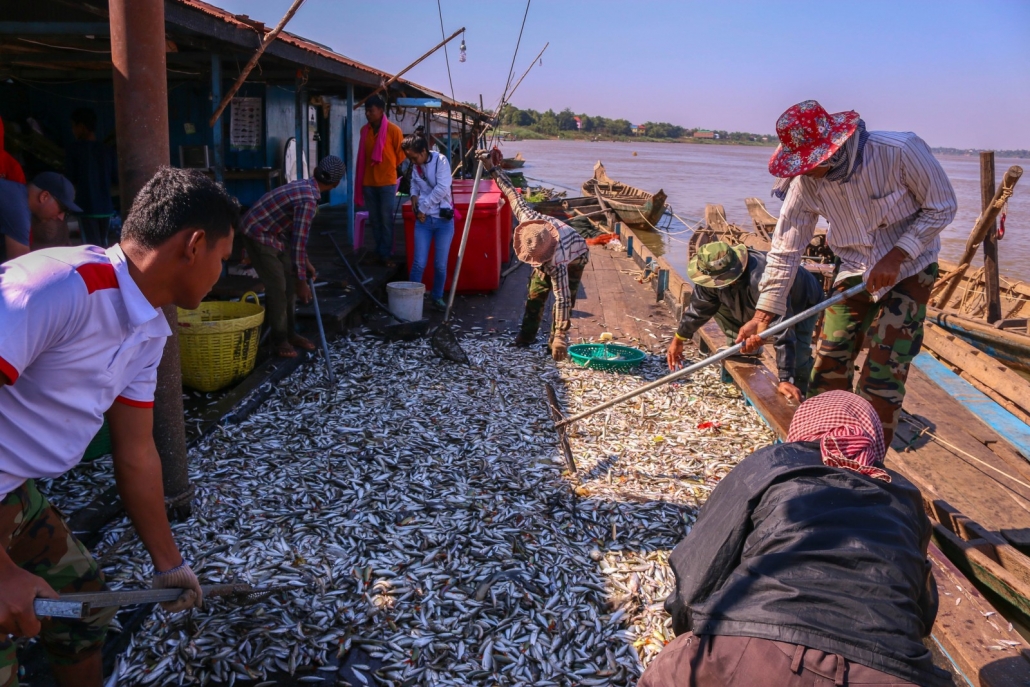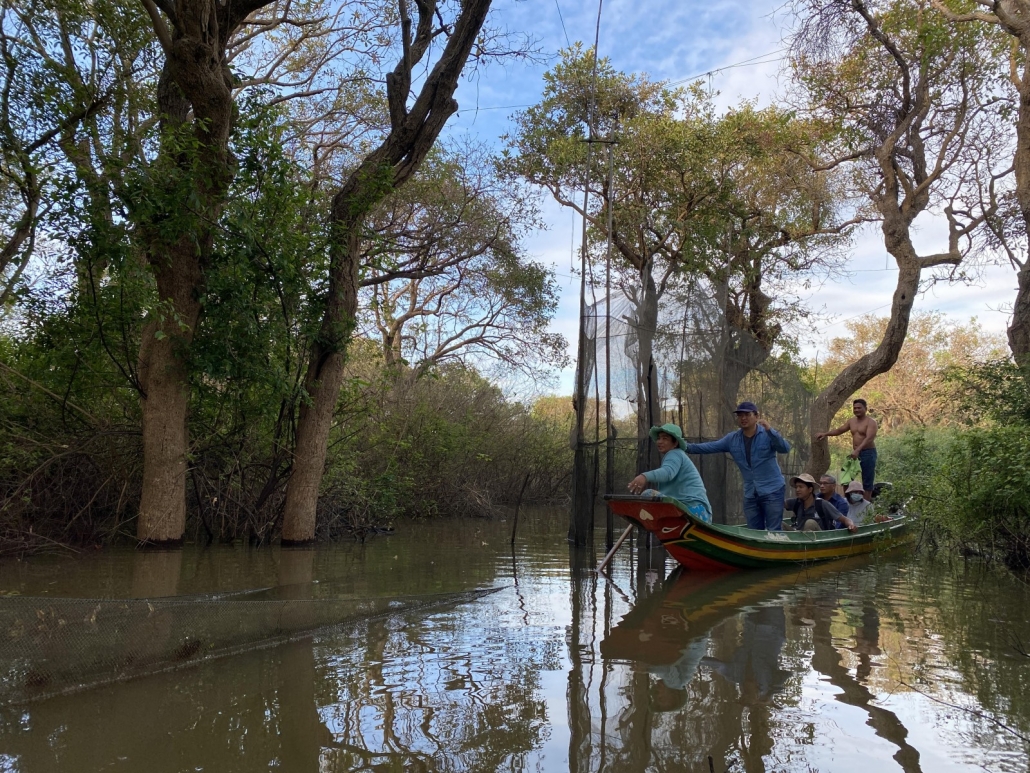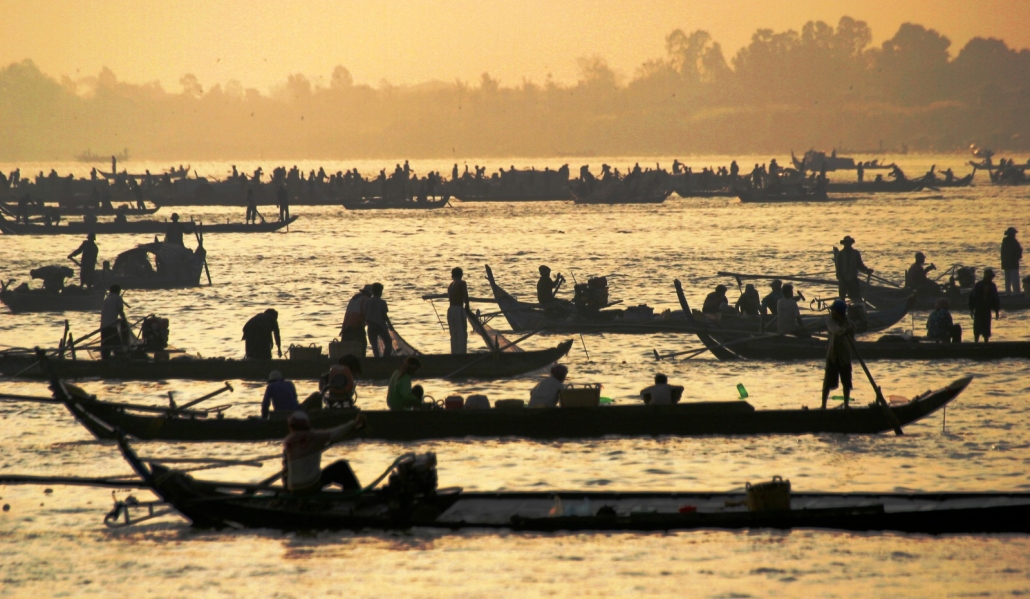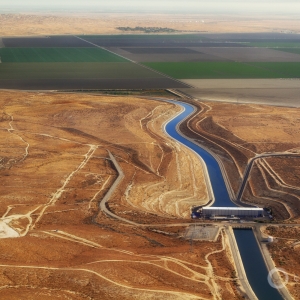
A dai fishery (stationary bagnets) on the Tonle Sap River, which connects the Mekong with the Tonle Sap Lake. Photo Courtesy of Wonders of the Mekong
Southeast Asia’s main waterway faces substantial challenges. But these five developments could change the river’s course.
By Stefan Lovgren, Circle of Blue – March 22, 2021
For many years the warning signs flashed the same message: the Mekong River, Southeast Asia’s main waterway, was headed toward environmental disaster. The 2,700-mile-long ribbon of water, scientists cautioned, could not withstand the onslaught of dam construction, overfishing, and pollution. Yet somehow the river that might be called the most important in the world continued to provide a livelihood for the tens of millions of people in the Lower Mekong Basin.
Then, in 2019, the bounty seemed finally, and literally, to dry up. The monsoon rains that fill the river each year and turn the basin into a wonderland of biological riches didn’t come until the mighty Mekong had been reduced, in parts, to a virtual trickle. In Cambodia’s interconnected Tonle Sap Lake, the heart of the world’s largest inland fishery, some fishers reported catch declines of more than 80 percent.
What caused this? An El Niño-induced drought, exacerbated by climate change, no doubt played a part. But so did the cascade of hydroelectric dams that China operates in the upper reaches of the Mekong basin, which starts in the Tibetan highlands and runs through six countries. As the drought intensified, China held back an even greater share of the river severely disrupting the water flow downstream.
In stretches where the river divides Thailand from Laos, the normally chocolate brown waters turned blue. “Hungry water,” observers called it, because it had been starved of the nutritious sediments crucial to agriculture. Most people pointed to the Xayaburi dam in Laos as the culprit. The dam, which came online in 2019, was the first dam on the main stem of the lower Mekong and a major plug in the system.
Fires returned that year to the forests around Tonle Sap Lake, sparking fears of 2016 when a third of the flooded forests that surround the lake were destroyed. These woodlands provide essential habitat for hundreds of species of commercially important and in many cases critically endangered fish. When the rains were delayed again in 2020, it seemed like the flood pulse driving the entire system would fail to materialize. By the time the rains arrived, water levels had once again reached historically low levels. And now, in the winter of 2021, the hungry water has returned.
Is this the new normal in the Mekong? For several years, I have reported on the environmental changes in one of the most biodiverse regions in the world. Much of that reporting has focused on the decline and degradation that is undeniably occurring throughout the basin. But I have also covered positive developments and innovative new approaches that, if increased and expanded, could reverse the river’s decline.
These are five such bright spots for the basin:
1. China Inches Toward Cooperation
China, which considers water management data to be a state secret, has long been criticized for operating its 11 Mekong mainstem dams without much regard for downstream fishers and farmers. But in late 2019, China made a deal with the Mekong River Commission, an inter-governmental organization to which it had previously paid little attention, promising to share year-round water level and rainfall data, and to notify neighboring countries of any unusual operations.
Calls for greater Chinese transparency intensified after a report last year by the U.S. company Eyes on Earth showed that Chinese dams had held back excess monsoon rains, exacerbating the drought gripping the Lower Mekong. Since then, the U.S. State Department and the Stimson Center launched the Mekong Dam Monitor, a tracking tool that uses remote sensing and satellite imagery to provide real-time reporting on climate conditions, estimated river flows, and dam operations. “For the first time, we have weekly data on all of China’s dams, and we can show how they’re operating together to change the flow of the river,” says Brian Eyler, who leads the project at the Stimson Center in Washington, D.C.
China has rejected criticism of its dam operations and labeled it part of a U.S. government-driven conspiracy. But there are signs that Chinese officials are listening. Earlier this year, when water levels fell dramatically overnight in northern Thailand, the dam monitor quickly correlated the river’s drop with increased reservoir levels at Jinghong, the last in the cascade of Chinese dams. Within hours of an alert being issued, Chinese water authorities notified neighboring countries that special operations would be conducted at Jinghong for the next three weeks. It is the kind of acknowledgment that wouldn’t have been made in the past.
2. Cambodia’s Hydro Hiatus
Late last year, Cambodia announced it would not develop any new hydropower dams on the mainstem Mekong for at least the next 10 years, pausing plans for two large dams at Sambor and Stung Treng. The moratorium was greeted with great enthusiasm among conservationists, who had warned that the Sambor dam, in particular, would essentially wipe out the basin’s most important fisheries, as well as its last remaining population of river dolphins.
“I think the government has become mindful of the real and dreadful consequences created by hydropower plants, which alter the natural pulse of the river, deplete fish stocks, cast dry spells, and harm the biodiversity of the entire Mekong,” says Pou Sothirak, who is the executive director of the Cambodian Institute for Cooperation and Peace, and a former Cambodian energy minister.
It’s safe to say the decision was not taken solely for environmental reasons. While a Japanese study showed project costs far outweighing benefits, the drought has further exposed economic vulnerabilities of hydropower projects in the region. Cambodia’s two-year-old Lower Sesan 2 dam, built on a Mekong tributary, has not lived up to its supply projections. “The lack of reliable water flow is driving decisions away from large hydropower in Cambodia,” says Eyler.
3. Solar Rise
Could the solar revolution that’s been touted for Southeast Asia for the past decade finally be arriving? With solar technologies not only catching up to but surpassing hydropower in terms of price and effectiveness, the Asian Development Bank has dramatically increased funding of solar projects in the region. This year the price of solar power fell to record lows.
Vietnam, which produced nine gigawatts of solar power just from rooftops last year, is leading the way, while Thailand is rapidly developing its capacity for floating solar installations that can be placed on lakes and reservoirs. “There are many ways to produce electricity that is not hurting the natural ecosystems,” says Pianporn Deetes, an environmental activist and campaigner with International Rivers.
Solar power is ideally deployed in microgrids, which operate autonomously from traditional electricity grids and respond better to imbalances in supply and demand. Energy experts say such localized grids will be instrumental in bringing power to rural areas. Mixed systems of renewable energy and microgrids are now being piloted on several Thai islands and in remote mountainous regions that are hard to reach with conventional transmission lines.
4. Fish Reserves
River reserves — protected areas where fishing is restricted or banned — have become common throughout the Lower Mekong. While the benefit of marine protected areas for fisheries production and conservation has long been documented, the effects of such reserves in freshwater systems have largely been ignored. Recent studies, however, show that river fish benefit from protected zones at least as much and often more than their marine counterparts.
Most reserves in the Mekong are small and locally managed. “Fish conservation zones provide communities with a sense of ownership over their aquatic resources and a vehicle for thinking about sustainable management and resource use to ensure fish are available for their children to catch,” says Erin Loury, a fish biologist and with the conservation group Fishbio. A survey by her organization in Laos found 1,300 community-based fish sanctuaries. “In the absence of these reserves, fisheries would be mostly or completely unregulated,” Loury says.
Fish reserves could play an important role in Tonle Sap Lake, which has historically produced hundreds of thousands of tons of fish a year, more than from all of North America’s rivers and lakes combined. About 15 percent of the lake, Southeast Asia’s largest lake is off limits to fishers, having been apportioned as a no-harvest reserve, a number that conservationists hope will be increased. “Fish reserves not only protect large-bodied species, which are often the most vulnerable, but have also been shown to have spillover effects, increasing fish catches in adjacent areas,” says Zeb Hogan, a fish biologist at the University of Nevada, Reno, and the director of the USAID-supported research project Wonders of the Mekong.
5. Science Ramping Up
Decisions in the Mekong have generally been driven by political and economic agendas that extend little regard for science and environmental concerns. But this may be changing, as moves like Cambodia’s dam moratorium suggest. Meanwhile, science in the region continues to expand, with additional research centers, monitoring programs, and technology. “Scientists are very eager to share their information in the hope that policymakers and managers will use the information to make more informed decisions,” says Sudeep Chandra, director of the University of Nevada Global Water Center, who works in the region.
The Mekong River Commission, for one, has been politically empowered. For years the commission churned out technical data that was largely ignored. Now there’s hope that increased communication and data sharing across the basin will allow for more transparent and open governance of the river. “We need more dialogue about how water is being used between countries,” says Hogan, whose USAID project has published more than a dozen Mekong-related studies as part of a special issue of the journal Water.
Hogan added that the basin’s numerous challenges should not cloud out signs of progress. “You hear enough negative news about a place and it might cause people to lose hope or think there is nothing positive happening in the region,” Hogan says. “But it’s not always the case. In Cambodia, the Mekong River functions more or less the way it should, and it’s very important not to lose sight of that. The bright spots we’re talking about are not necessarily happening strategically, but they are happening and that’s a good thing. They are the beginning of what’s needed to turn the tide.”






